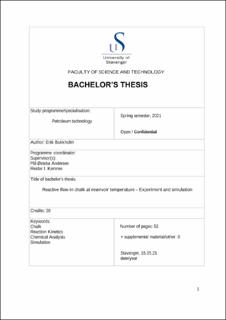| dc.contributor.advisor | Korsnes, Reidar Inge | |
| dc.contributor.advisor | Andersen, Pål Østebø | |
| dc.contributor.author | Bukkholm, Erik Trøiel | |
| dc.date.accessioned | 2021-09-07T16:31:12Z | |
| dc.date.available | 2021-09-07T16:31:12Z | |
| dc.date.issued | 2021 | |
| dc.identifier | no.uis:inspera:78834598:22740688 | |
| dc.identifier.uri | https://hdl.handle.net/11250/2774453 | |
| dc.description.abstract | This thesis seeks to study how 0.219 M MgCl2 brine flooded through chalk cores at reservoir temperatures will chemically react when flooded through at various flowrates. We used two different chalk cores. The cores were from Stevns Klint in Aalborg, Denmark and Kansas, USA and are referred to as SKA3 and KR30 respectively. A triaxial cell was used for each of the cores for this experiment, with SKA3 being run at 100ºC and KR30 at 130ºC. Pore pressure and confining pressure was maintained at a constant level throughout the experiment, only the flowrate was varied. For SKA3 a pore pressure 0.7 MPa and a confining pressure of 2.0 MPa was used, while KR30 was run at equal pore pressure but lower confining pressure (1.2 MPa). The confining pressures were deliberately low in order to minimize compaction of the cores. The effluents were sampled regularly and then analyzed with an ion chromatography machine to see how varying the flowrate affects the concentrations of ions present in the brine after flooding. From plotting these results, we could see a general trend that lowering the flowrate increased the concentration of calcium present in the effluents. This shows that the brine had a greater chemical effect on the chalk when the flowrate was lower. At higher flowrates, the opposite behavior was shown. The data gathered from core SKA3 showed a greater tendency to deviate from this behavior, often failing to reach steady state. Core KR30 showed no deviation from the general trend, with lower flowrates always increasing calcium concentration and vice versa. Comparing these results with similar tests performed on Stevns Klint cores from the same block as SKA3 (Olsen, A. T, 2020) suggest that temperature was the deciding factor in the trouble to reach steady state, not the chalk type. After completing the floodings the gathered data was then compared to a model developed to predict the concentrations of ions in the flooding of a chalk sample by MgCl2-based brines. A set of mathematical equations was solved to predict ion concentrations at different rates. The tuned model was plotted alongside the experimental measurements for comparison. We were able to fit the model to a satisfactory degree, where it was able to reasonably predict the concentrations of the ions at a given flowrate. | |
| dc.description.abstract | This thesis seeks to study how 0.219 M MgCl2 brine flooded through chalk cores at reservoir temperatures will chemically react when flooded through at various flowrates. We used two different chalk cores. The cores were from Stevns Klint in Aalborg, Denmark and Kansas, USA and are referred to as SKA3 and KR30 respectively. A triaxial cell was used for each of the cores for this experiment, with SKA3 being run at 100ºC and KR30 at 130ºC. Pore pressure and confining pressure was maintained at a constant level throughout the experiment, only the flowrate was varied. For SKA3 a pore pressure 0.7 MPa and a confining pressure of 2.0 MPa was used, while KR30 was run at equal pore pressure but lower confining pressure (1.2 MPa). The confining pressures were deliberately low in order to minimize compaction of the cores. The effluents were sampled regularly and then analyzed with an ion chromatography machine to see how varying the flowrate affects the concentrations of ions present in the brine after flooding. From plotting these results, we could see a general trend that lowering the flowrate increased the concentration of calcium present in the effluents. This shows that the brine had a greater chemical effect on the chalk when the flowrate was lower. At higher flowrates, the opposite behavior was shown. The data gathered from core SKA3 showed a greater tendency to deviate from this behavior, often failing to reach steady state. Core KR30 showed no deviation from the general trend, with lower flowrates always increasing calcium concentration and vice versa. Comparing these results with similar tests performed on Stevns Klint cores from the same block as SKA3 (Olsen, A. T, 2020) suggest that temperature was the deciding factor in the trouble to reach steady state, not the chalk type. After completing the floodings the gathered data was then compared to a model developed to predict the concentrations of ions in the flooding of a chalk sample by MgCl2-based brines. A set of mathematical equations was solved to predict ion concentrations at different rates. The tuned model was plotted alongside the experimental measurements for comparison. We were able to fit the model to a satisfactory degree, where it was able to reasonably predict the concentrations of the ions at a given flowrate. | |
| dc.language | eng | |
| dc.publisher | uis | |
| dc.title | Reactive flow in chalk at reservoir temperature – Experiment and simulation | |
| dc.type | Bachelor thesis | |
